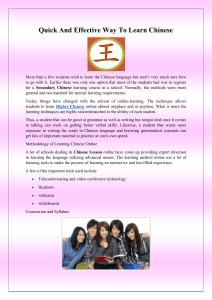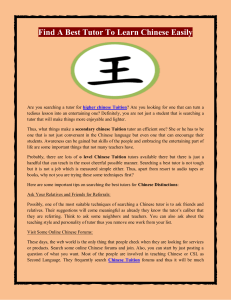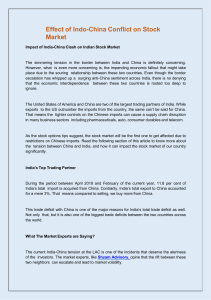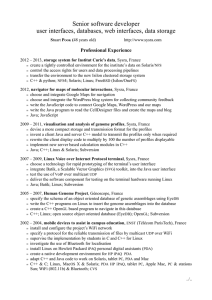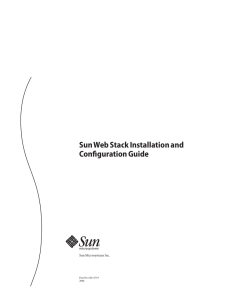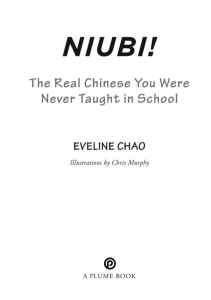Simplified Chinese Solaris Release Overview
publicité
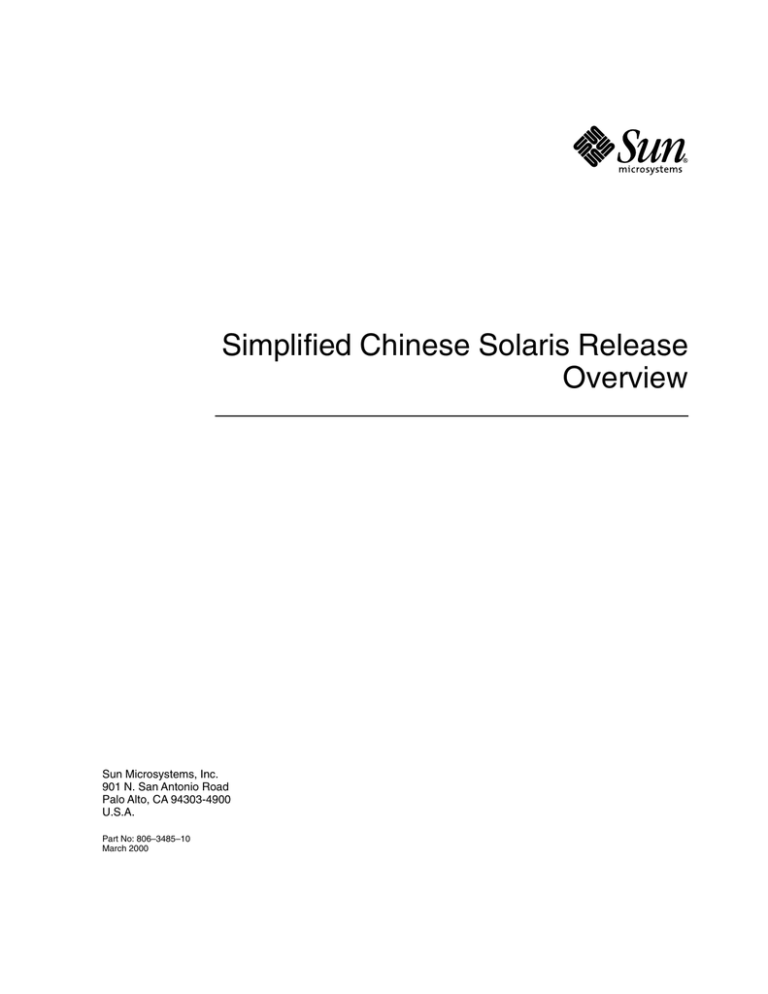
Simplified Chinese Solaris Release Overview Sun Microsystems, Inc. 901 N. San Antonio Road Palo Alto, CA 94303-4900 U.S.A. Part No: 806–3485–10 March 2000 Copyright 2000 Sun Microsystems, Inc. 901 N. San Antonio Road Palo Alto, CA 94303-4900 U.S.A. All rights reserved. This product or document is protected by copyright and distributed under licenses restricting its use, copying, distribution, and decompilation. No part of this product or document may be reproduced in any form by any means without prior written authorization of Sun and its licensors, if any. Third-party software, including font technology, is copyrighted and licensed from Sun suppliers. Parts of the product may be derived from Berkeley BSD systems, licensed from the University of California. UNIX is a registered trademark in the U.S. and other countries, exclusively licensed through X/Open Company, Ltd. Sun, Sun Microsystems, the Sun logo, SunSoft, SunDocs, SunExpress, and Solaris are trademarks, registered trademarks, or service marks of Sun Microsystems, Inc. in the U.S. and other countries. All SPARC trademarks are used under license and are trademarks or registered trademarks of SPARC International, Inc. in the U.S. and other countries. Products bearing SPARC trademarks are based upon an architecture developed by Sun Microsystems, Inc. The OPEN LOOK and Sun™ Graphical User Interface was developed by Sun Microsystems, Inc. for its users and licensees. Sun acknowledges the pioneering efforts of Xerox in researching and developing the concept of visual or graphical user interfaces for the computer industry. Sun holds a non-exclusive license from Xerox to the Xerox Graphical User Interface, which license also covers Sun’s licensees who implement OPEN LOOK GUIs and otherwise comply with Sun’s written license agreements. RESTRICTED RIGHTS: Use, duplication, or disclosure by the U.S. Government is subject to restrictions of FAR 52.227–14(g)(2)(6/87) and FAR 52.227–19(6/87), or DFAR 252.227–7015(b)(6/95) and DFAR 227.7202–3(a). DOCUMENTATION IS PROVIDED “AS IS” AND ALL EXPRESS OR IMPLIED CONDITIONS, REPRESENTATIONS AND WARRANTIES, INCLUDING ANY IMPLIED WARRANTY OF MERCHANTABILITY, FITNESS FOR A PARTICULAR PURPOSE OR NON-INFRINGEMENT, ARE DISCLAIMED, EXCEPT TO THE EXTENT THAT SUCH DISCLAIMERS ARE HELD TO BE LEGALLY INVALID. Copyright 2000 Sun Microsystems, Inc. 901 N. San Antonio Road Palo Alto, CA 94303-4900 U.S.A. Tous droits réservés Ce produit ou document est protégé par un copyright et distribué avec des licences qui en restreignent l’utilisation, la copie, la distribution, et la décompilation. Aucune partie de ce produit ou document ne peut être reproduite sous aucune forme, par quelque moyen que ce soit, sans l’autorisation préalable et écrite de Sun et de ses bailleurs de licence, s’il y en a. Le logiciel détenu par des tiers, et qui comprend la technologie relative aux polices de caractères, est protégé par un copyright et licencié par des fournisseurs de Sun. Des parties de ce produit pourront être dérivées du système Berkeley BSD licenciés par l’Université de Californie. UNIX est une marque déposée aux Etats-Unis et dans d’autres pays et licenciée exclusivement par X/Open Company, Ltd. Sun, Sun Microsystems, le logo Sun, SunSoft, SunDocs, SunExpress, et Solaris sont des marques de fabrique ou des marques déposées, ou marques de service, de Sun Microsystems, Inc. aux Etats-Unis et dans d’autres pays. Toutes les marques SPARC sont utilisées sous licence et sont des marques de fabrique ou des marques déposées de SPARC International, Inc. aux Etats-Unis et dans d’autres pays. Les produits portant les marques SPARC sont basés sur une architecture développée par Sun Microsystems, Inc. L’interface d’utilisation graphique OPEN LOOK et Sun™ a été développée par Sun Microsystems, Inc. pour ses utilisateurs et licenciés. Sun reconnaît les efforts de pionniers de Xerox pour la recherche et le développement du concept des interfaces d’utilisation visuelle ou graphique pour l’industrie de l’informatique. Sun détient une licence non exclusive de Xerox sur l’interface d’utilisation graphique Xerox, cette licence couvrant également les licenciés de Sun qui mettent en place l’interface d’utilisation graphique OPEN LOOK et qui en outre se conforment aux licences écrites de Sun. CETTE PUBLICATION EST FOURNIE “EN L’ETAT” ET AUCUNE GARANTIE, EXPRESSE OU IMPLICITE, N’EST ACCORDEE, Y COMPRIS DES GARANTIES CONCERNANT LA VALEUR MARCHANDE, L’APTITUDE DE LA PUBLICATION A REPONDRE A UNE UTILISATION PARTICULIERE, OU LE FAIT QU’ELLE NE SOIT PAS CONTREFAISANTE DE PRODUIT DE TIERS. CE DENI DE GARANTIE NE S’APPLIQUERAIT PAS, DANS LA MESURE OU IL SERAIT TENU JURIDIQUEMENT NUL ET NON AVENU. 011025@2471 Contents Preface 1 5 Overview of Features Localized Features New Features 9 9 9 Other Localized Features 2 System Environment Setting the Locale 13 Locale Categories 14 TTY Environment 15 10 13 3 4 Simplified Chinese Solaris Release Overview • March 2000 Preface Simplified Chinese Solaris Release Overview contains information specific to the Simplified Chinese Solaris™ 8 operating environment. Who Should Use This Book This document is for someone who wants a brief overview of the localized product features of the Simplified Chinese Solaris 8 operating environment. How This Book Is Organized The chapters of this book address the following: Chapter 1 lists the Simplified Chinese Solaris facilities for handling Simplified Chinese text and cultural conventions, including new features. Chapter 2 introduces basic terms and features of the Simplified Chinese Solaris 8 localization. 5 Related Books For the most up-to-date information about the release, see the document that relates to your hardware platform: ■ ■ Asian Solaris 8 (SPARC Platform Edition) Release Notes Asian Solaris 8 (Intel Platform Edition) Release Notes For general users: ■ ■ ■ Solaris User’s Guide Solaris Advanced User’s Guide Simplified Chinese Solaris User’s Guide For system administrators and advanced users: ■ Simplified Chinese Solaris System Administrator’s Guide For developers/programmers and advanced users: ■ International Language Environments Guide What Typographic Changes Mean The following table describes the typographic changes used in this book. TABLE P–1 Typographic Conventions Typeface or Symbol Meaning Example AaBbCc123 The names of commands, files, and directories; on-screen computer output Edit your .login file. Use ls -a to list all files. machine_name% You have mail. AaBbCc123 AaBbCc123 What you type, contrasted with on-screen computer output machine_name% su Command-line placeholder: To delete a file, type rm filename. replace with a real name or value 6 Simplified Chinese Solaris Release Overview • March 2000 Password: TABLE P–1 Typographic Conventions (Continued) Typeface or Symbol Meaning Example AaBbCc123 Book titles, new words or terms, or words to be emphasized Read Chapter 6 in User’s Guide. These are called class options. You must be root to do this. Shell Prompts in Command Examples The following table shows the default system prompt and superuser prompt for the C shell, Bourne shell, and Korn shell. TABLE P–2 Shell Prompts Shell Prompt C shell prompt machine_name% C shell superuser prompt machine_name# Bourne shell and Korn shell prompt $ Bourne shell and Korn shell superuser prompt # Preface 7 8 Simplified Chinese Solaris Release Overview • March 2000 CHAPTER 1 Overview of Features The Simplified Chinese Solaris 8 operating environment is the SunSoft™ internationalization and Simplified Chinese localization of the Solaris operating environment as well as the Common Desktop Environment (CDE) and OpenWindows™ window systems. The Simplified Chinese Solaris 8 operating environment incorporates many facilities for handling Simplified Chinese text and cultural conventions. It provides a set of commands and other features for the operation and maintenance of the Solaris operating environment and CDE facilities for Simplified Chinese. The Simplified Chinese Solaris 8 operating environment is part of the Sun® internationalization efforts, which include and integrate many Asian and European languages. Localized Features New Features The following list summarizes new features of the Simplified Chinese Solaris 8 operating environment: Locale The Simplified Chinese Solaris 8 operating environment includes the zh.UTF-8 locale which supports Unicode 3.0. 9 Partial Locales Supported in Solaris Software CDs Now partial zh, zh.GBK and zh.UTF-8 which support most Simplified Chiniese features including minimum Bitmap Fonts, TrueType Fonts and Input Methods are included on the Solaris 8 Software CDs. Other full locale features, including message translations and optional fonts are on the Solaris 8 Language CD. New iconv Modules Solaris 8 provides new iconv modules to support HZ-GB-2312. ■ ■ ■ ■ ■ HZ-GB-2312%UTF-8.so HZ-GB-2312%zh_CN.euc.so HZ-GB-2312%zh_CN.gbk.so UTF-8%HZ-GB-2312.so zh_CN.euc%HZ-GB-2312.so Other Localized Features The following list summarizes key features of the Simplified Chinese Solaris 8 operating environment: 10 ■ Contains the Simplified Chinese Solaris operating environment, CDE, and OpenWindows ■ Supports multibyte and wide characters ■ Supports multiple character sets ■ Supports different Simplified Chinese coding conventions for the GB2312-80 character set for file names and contents, terminals (TTY) and email contents, display messages, and so on ■ Uses the regular Sun keyboards ■ Supports dedicated Simplified Chinese input methods ■ Allows users to add new input methods with the code table interface ■ Uses Simplified Chinese fonts for output with CDE facilities ■ Interfaces with major existing equipment, using GB2312-80 code ■ Incorporates an open interface that allows system programmers to use their own Simplified Chinese input conversion modules and font files ■ Implements the ANSI C setlocale library to internationalize existing applications and customize applications for local cultural conventions ■ Provides Simplified Chinese bitmap and scalable fonts ■ Supports Simplified Chinese input and output at the Xlib and toolkit level, including Motif toolkits Simplified Chinese Solaris Release Overview • March 2000 ■ Supports Simplified Chinese messages for operating system commands, libraries, and applications ■ Provides localized installation ■ Provides localized Solaris Desktop Tools™ that display Simplified Chinese labels and messages; also supports user input of Simplified Chinese text, file names, and so on Input Methods The Simplified Chinese Solaris 8 operating environment is localized for the following input methods: ■ zh, zh.GBK and zh.UTF-8 locales ■ ■ ■ ■ zh locale ■ ■ ■ ■ ■ ■ ■ ■ Location Code Pinyin Full Pinyin Stroke Golden Intelligent Pinyin Chinese Symbol (two-column ASCII characters) zh.GBK and zh.UTF-8 locales ■ ■ ■ ■ ■ New Pinyin New Shuang Pin Quan Pin Yin Japanese (kanji) Hanja Zhuyin Unicode zh.GBK locale ■ GBK code The Simplified Chinese Solaris 8 operating environment provides a code table interface for adding other input methods. Overview of Features 11 12 Simplified Chinese Solaris Release Overview • March 2000 CHAPTER 2 System Environment The Solaris 8 operating environment builds inherent internationalization features into every localized product. Sun’s system localization for the Simplified Chinese Solaris 8 operating environment incorporates the following essential environmental elements on top of internationalization: ■ ■ A locale includes the specification of a language, territory, code set, and other features. The Simplified Chinese Solaris operating environment includes the following locales: ■ C – ASCII English environment ■ zh – Simplified Chinese environment in EUC ■ zh.GBK – Simplified Chinese environment in GBK, an extension of GB2312-80 ■ zh.UTF-8 – Simplified Chinese environment in Unicode 3.0. A category is a set of language and cultural environment dependent features, defined by ANSI C, whose behavior depends on the locale. For example, the Simplified Chinese locale and the English/ASCII locale each have a category that defines how time and dates are displayed according to the cultural norm, and the actual Simplified Chinese or English/ASCII characters for time and date. The categories are listed in “Locale Categories ” on page 14. The Simplified Chinese Solaris operating environment localization facilities support the ANSI C recommendations for internationalization and localization. The ANSI C recommendations define a user’s locale and the categories within each locale. Setting the Locale Three components make up the Simplified Chinese Solaris localization facility: 13 ■ Localization interface—User-level shell environment variables set the current working locale for each category. The application-level setlocale() function sets the locale for each category. ■ Localization objects—These objects hold information suitable for functions that are specific to a locale. ■ Localization support features—These features include appropriate supporting commands and functions as well as facilities for creation, addition, and maintenance of localization objects. The Simplified Chinese Solaris 8 operating environment defines six categories to describe the local environment. These categories allow the localization of character typing and conversion functions, date and time, numeric representation, monetary format, collation order, and program messages. Each category can have multiple localizations. For example, date and time can be displayed in C locale format or Simplified Chinese. Applications can switch between locale settings by using the setlocale() function. Users can change their locale settings with shell environment variables. Each category names an existing locale. The setlocale function directly sets or queries the setting of these categories. Internationalized functions use these settings to access the appropriate tables for the desired locale. Environment variables can be used to set the categories indirectly: when setlocale() sets the categories to the default setting for that application, it uses the setting of each environment variable to set the associated categories. The setlocale() function used in this way does not change the settings of environment variables, it only reads their settings. Locale Categories The Simplified Chinese Solaris 8 operating environment allows you to set the Chinese environment or use the English environment. You can specify the following: ■ General locale setting—for all locale-related aspects of the environment. ■ Specific locale category settings—for particular aspects of the environment. The general locale setting is LC_ALL. The specific locale category settings are listed below. In this book, the designation LC_XXX refers to any one of the locale category settings. The specific locale category settings are: ■ 14 LC_CTYPE Simplified Chinese Solaris Release Overview • March 2000 ■ ■ ■ ■ ■ LC_TIME LC_NUMERIC LC_MONETARY LC_COLLATE LC_MESSAGES The LC_ALL identifier invokes all of the categories. TTY Environment The Simplified Chinese Solaris 8 operating environment supports terminals using GB2312 code. The terminals must have a method to input Simplified Chinese characters, that is, run their own Simplified Chinese input conversion. For information on using different types of terminals, refer to Simplified Chinese Solaris System Administrator’s Guide and International Language Environments Guide. System Environment 15 16 Simplified Chinese Solaris Release Overview • March 2000

